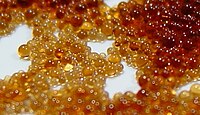
Photo from wikipedia
One-pot conversion of alginic acid, which was derived from brown algae, to furfural was investigated using various solid acid catalysts. Among the solid acid catalysts tested, Amberlyst-15 showed the highest… Click to show full abstract
One-pot conversion of alginic acid, which was derived from brown algae, to furfural was investigated using various solid acid catalysts. Among the solid acid catalysts tested, Amberlyst-15 showed the highest activity in furfural production in aqueous media. When the effect of reaction media was examined by applying various organic solvent mixtures, it was found that γ-butyrolactone/water co-solvent system was selected as the most appropriate system for the reaction. Maximum furfural yield of 32.2% was obtained using Amberlyst-15 in the γ-butyrolactone/H2O at 210 °C for 20 min. Catalyst showed gradual deactivation behavior as the reaction proceeded, although the catalyst recovered its activity upon the simple treatment with sulfuric acid. N2 adsorption-desorption experiments, Fourier-transform infrared spectroscopy (FT-IR), back titration, and CHNS analysis were applied to investigate the physicochemical property of post-reaction samples, confirming that the leaching of the active sulfonic acid group and decrease in acid density was the major cause of deactivation.
Journal Title: Environmental research
Year Published: 2020
Link to full text (if available)
Share on Social Media: Sign Up to like & get
recommendations!